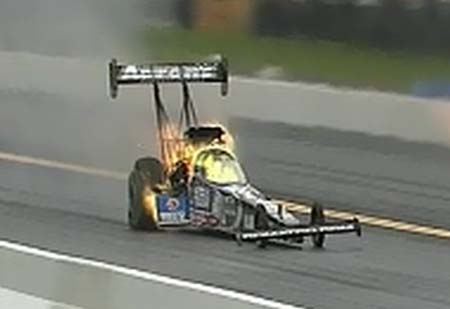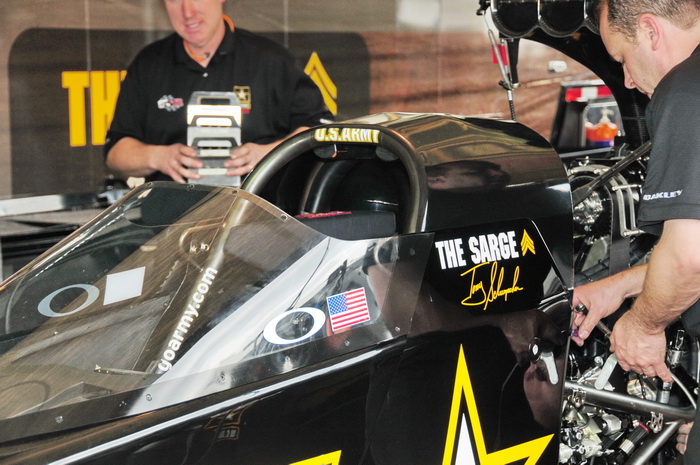NHRA CRIES FOUL ON SAFER COCKPIT, SCHUMACHER FUMES
 Don Schumacher has spent more than $100,000 developing what he believed was a safer cockpit and on Friday morning in Phoenix, the investment went up in flames. As far as the NHRA is concerned, his investment went up in flames in Reading, Pa., when a broken fuel line engulfed in flames the driver’s compartment of the dragster Antron Brown drives.
Don Schumacher has spent more than $100,000 developing what he believed was a safer cockpit and on Friday morning in Phoenix, the investment went up in flames. As far as the NHRA is concerned, his investment went up in flames in Reading, Pa., when a broken fuel line engulfed in flames the driver’s compartment of the dragster Antron Brown drives.
The sanctioning body handed down a ruling prior to Friday qualifying at the NHRA Arizona Nationals, telling the Don Schumacher Racing dragster teams that their shrouds atop the roll cages had to go.
The NHRA, after consultation with two aerodynamic specialists, one of whom they compensated, was told the shrouds had no definitive safety attributes [one suggesting it could be dangerous] and could provide a performance advantage. These studies suggested the shroud could deliver undisturbed air directly into the injector for increased horsepower.
Neither study definitely determined a performance advantage.

Don Schumacher has spent more than $100,000 developing what he believed was a safer cockpit and on Friday morning in Phoenix, the investment went up in flames. As far as the NHRA is concerned, his investment went up in flames in Reading, Pa., when a broken fuel line engulfed in flames the driver’s compartment of the dragster Antron Brown drives.
The sanctioning body handed down a ruling prior to Friday qualifying at the NHRA Arizona Nationals, telling the Don Schumacher Racing dragster teams that their shrouds atop the roll cages had to go.
The NHRA, after consultation with two aerodynamic specialists, one of whom they compensated, was told the shrouds had no definitive safety attributes [one suggesting it could be dangerous] and could provide a performance advantage. These studies suggested the shroud could deliver undisturbed air directly into the injector for increased horsepower.
Neither study definitely determined a performance advantage.
Videos of Brown’s engulfed cockpit and the perception of a performance advantage were enough for Graham Light, NHRA’s sr. vice president of operations, and Glen Gray, the sanctioning body’s tech director, ordered the shrouds removed.
Light wouldn’t say DSR deliberately deceived the tech department and pointed out it was clear by the studies the design didn’t live up to its intended purpose.
“They presented a new concept to our tech department over the winter,” said Light. “It was a shroud over the roll cage. Their intent was to shield the driver from fire coming into the cockpit. The whole concept was for that reason. The windshield … the canopy on the top. It was supposedly a safety innovation to help prevent fire from coming into the cockpit. Based on that intent, the NHRA tech department legalized it.
“It came to the tech department’s attention at Indy, by another team that had gone out and got another aerodynamic engineering company to do an evaluation on this, and what affect it has on airflow, over the cockpit, and what if any advantage that was.”
Light said the team wasn’t trying to “rat” out DSR but instead had declared its intentions to escalate its own research and development into this area with the intent of capitalizing the alleged performance advantage. This was the first time the NHRA had reportedly been presented with findings of an alleged performance advantage. The team, while offering to share its findings, refused to provide the NHRA with a copy citing intellectual property. The NHRA, according to Light, retained an aero expert to conduct a similar test.
The news his team’s off-season research and development was now illegal was met with strong objection from Don Schumacher, who left the track early in the day, claiming he was thoroughly disgusted with the way the NHRA had handled the situation.
Schumacher said his team was granted approval for the new cockpit configuration and with three races left in the season, this decision has him questioning the NHRA’s motives. Three of the team’s drivers are ranked in the top five in the standings.
“It’s just another DSR rule because I am not Alan Johnson, John Force or Kenny Bernstein,” Schumacher told CompetitionPlus.com on Friday. “That’s real clear to me. Those guys can do what they want, and have done it for many years. Alan Johnson runs Pomona with an illegal supercharger, wins Pomona and they [NHRA] don’t do anything. There’s guys out there competing with illegal heads and superchargers and parts within their superchargers. Why doesn’t the NHRA do anything about that?
“We [at DSR] get everything approved. Sometimes it takes the NHRA months to approve it. And then in a whim, they can declare something they’ve approved illegal. What good does it do to have anything approved? It’s meaningless. If they hear enough complaints from other teams they will go against you if you’re DSR. It’s very personal and very vindictive. I’m tired of it.”
Light said the NHRA took DSR at its word that this project was safety inspired. The NHRA’s greatest fear was not the safety shortcoming but instead the spending spree this could evoke.
“At Maple Grove, we saw the fire Antron had that clearly shows the cockpit full of flame,” said Light. “Antron was fine, obviously. He had minor burns on his firesuit. In the picture, it’s clearly engulfing the cockpit. Based on the report we now have, and the fact our tech department feels misled in the intent of what it was for, and they approved it based on safety, [after determining] that it’s now performance, even though they [DSR] deny it is, the decision was to make them take it off. 
“Otherwise everyone goes out and gets an aerodynamics engineer. Everybody spends a lot of money, the pecking order is still the same, and nothing changes and in a bad economy, all are going to have to spend a lot of money.”
Light doesn’t deny the NHRA made a mistake by not doing their due diligence in researching the alleged performance advantage. The NHRA, by its own admission, doesn’t have an aerodynamic engineer on retainer but claims an engineer of any field will suffice.
This admission brings to the forefront two glaring questions which went unasked in the early stages of the initial DSR presentation.
As an overseeing sanctioning body, why did the NHRA take DSR’s word in the first place?
Why didn’t the NHRA perform an independent study initially to determine if this was the intent instead of waiting until an unnamed team complained?
“That’s a good question,” Light responded. “For years, racers have developed things and given it to us, explained what they wanted to do and why. Our people look at it. Some it’s very clear that it isn’t what they are claiming. You deny those but you can’t deny everything, all new innovation or technology, because some of them might truly be cost saving. You can’t just adapt a policy and say nothing new ever will be on these cars. There will be better things. They [NHRA tech department] took their word [DSR] for what the intent was. Our guys looked at it and based on our experience, none of them being aerodynamic engineers, believed it.
“Well, we made a mistake. Now we have something that every other team is going to have to spend a lot of money getting engineers and spending money … all for what?” he said.
For now, Schumacher points out that he’s the only one who spent money while the competition merely lobbied to have his safety innovation nullified. He questions the validity of how the tests were conducted and alleges the determinations were made from looking at photos of the cars at speed and without conducting their investigations of any of these cars in person.
“I spent tens of thousands of dollars trying to create a fully enclosed drivers cockpit for safety,” contended Schumacher. “[The configuration] weighed more and cost me a whole bunch of money. I’m done. Done. I’m thoroughly disgusted in the management.
“Any engineer should want to put cameras on the car and strings [to measure airflow],” said Schumacher. “This way they could determine what was really going on in the car airflow wise.”
Light said DSR was not fined or sanctioned because of the findings citing the so-called performance advantages and safety shortcomings might have been an honest mistake on their behalf.
“Maybe [DSR] didn’t do their homework, just like we didn’t do our homework,” Light contends. “The fact is, we now have this information. It’s not helping. It’s not accomplishing what it was intended to do.”
After two sessions, only one of the three DSR Top Fuel cars was qualified in the top half of the field, although Schumacher said the removal of the shrouds didn’t change the team’s tuning decisions.
A thoroughly disgusted Schumacher said the thought of withdrawing his teams crossed his mind initially.
“I’m disappointed enough in NHRA’s management enough that if my teams weren’t in a position fighting for this championship and we didn’t have major sponsorships, I would have packed them up and left,” said Schumacher. “Undoubtedly, NHRA’s management hates me and DSR, that’s the only way I can look at it.”






































